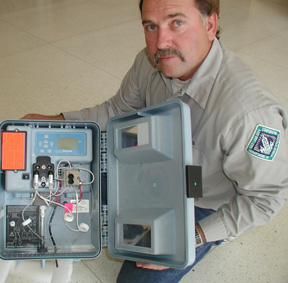Fluoridation to Begin October 1
Salt Lake County water suppliers prepare to meet deadline
Florence Reynolds, Salt Lake City Water Quality and Treatment Administrator
September 11, 2003
|
Over the past year facilities have been built or expanded to include the necessary fluoridation feeding and monitoring equipment. The Department of Public Utilities and its wholesale suppliers, the Metropolitan Water District of Salt Lake & Sandy and the Jordan Valley Water Conservancy District will meet the deadline.
Salt Lake Valley Health officials point out that the legislation was written requiring all of Salt Lake County’s water suppliers to add fluoride, unless a totally separate, independent water system is operated within that community. Costs have been a major concern and grant money for purchasing the chemical and monitoring equipment has not been found. Water suppliers have borne the full capital costs and the ongoing operation and maintenance costs of the fluoridation systems. These costs will become part of suppliers’ rate base and passed on to the consumer.
Smaller communities, because of economy of scale, will probably see higher per capita costs. Costs could be further increased because most small communities get their water from wells. Each well has to be equipped with a flouridation system, even if the well is only operated during the summer season.
The effective fluoride concentration is between 0.8 and 1.2 mg/l. Higher concentrations may lead to fluorosis, a mottling of the teeth, lower concentrations do not provide the desired cavity prevention benefit. Therefore, water suppliers are installing the necessary monitoring equipment to ensure dosages are within the optimum range. Since many childern receive fluoride supplements, once the public drinking water supply is fluoridated, supplements should be discontinued. If there is a question about the additions of fluoride, public drinking water consumers should talk to their dentist and/or Salt Lake Valley Health.
Some consumers have indicated a desire to remove the fluoride from the water at their tap. It is relatively difficult to remove fluoride once it has been put in the water supply. Carbon filters will not remove fluoride; however, it can be removed with reverse osmosis or distillation. Both of these processes are somewhat cumbersome for the average homeowner to maintain. Proper maintenance of these processes is necessary to assure that the overall quality of the drinking water is not affected at the tap.
|
Additional information about fluoridation can be obtained by contacting the Cathy Baebler at Salt Lake Valley Health, 468-2794.

